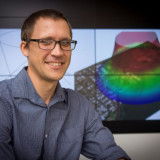Generative Adversarial Networks as a Fast Surrogate Model for Simulations
Presentation
Authors: Stuart Mead
Event: International Union of Geodesy and Geophysics (IUGG) General Assembly
Summary: An oral presentation at the IUGG conference.
The complexity and level of detail in numerical models for geosciences have increased as computational power has become more available and parallelism and new computational techniques have reduced the computational burden of numerical modelling. However simulations still pose a large computational challenge where a large number of simulations are required to adequately sample the input space.
One approach to alleviating these limitations is through construction of a surrogate model. A surrogate (or metamodel) is a model of the simulation results within a defined parameter space. Surrogate models typically learn from simulation results to create a fast approximation to the numerical model. We have been using Generative Adversarial Networks (GAN’s) as a surrogate model to depth-averaged simulations of debris avalanches at Ruapehu volcano, New Zealand. This GAN appears highly successful, creating inundation outlines of volcanic debris avalanches (VDA) with high precision (>90% similarity to simulations in some cases) and more than 130,000 times faster than VDA simulations. Our trials of GANs so far highlight a few key points: (1) well-trained GAN surrogates have high accuracy in reproducing model footprints, (2) the surrogate GANs show better accuracy when constrained to groups with similar simulation inputs (i.e. it is not generalizable), and (3) different loss functions (mean-square error vs. mean absolute error) affect trainability and accuracy. These results, and our attempts to push the limits of GAN’s to problems that consider time-varying inputs, such as wind, will be highlighted.

Stuart Mead
Earth Scientist